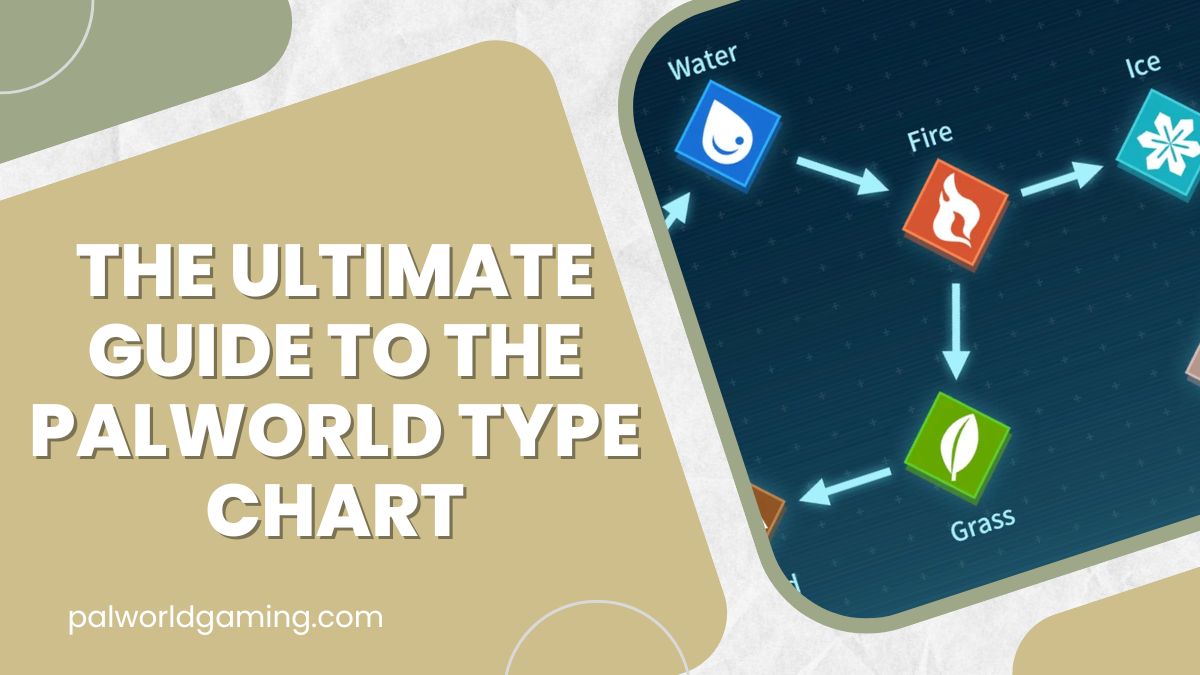As an avid Palworld player, I can’t emphasize enough the importance of understanding the intricate Palworld type chart. This Rock-Paper-Scissors system governing the strengths and weaknesses of Pals lies at the heart of strategic combat in the game. Mastering it can mean the difference between emerging victorious or facing a humiliating defeat at the hands of your rivals.
In this comprehensive guide, I’ll walk you through every facet of the Palworld type chart, arming you with the knowledge to build an unbeatable team and conquer even the toughest challenges the game throws your way.
Understanding the Fundamentals
Palworld divides its diverse Pal species into nine distinct elemental groupings: Water, Fire, Grass, Electric, Ground, Ice, Dragon, Dark, and Neutral. The type chart lays out the inherent weaknesses and resistances of these Types when pitted against one another.
For instance, an Electric Pal naturally overpowers a Water-type foe, while a Ground Pal holds the upper hand against an Electric adversary. These engrained properties significantly influence the outcome of battles, as exploiting favorable matchups can amplify your damage output, while adverse Type combinations can severely hinder your offensive prowess.
Mastering the Matchup Nuances
While the Palworld type chart may seem daunting at first glance, its elegance lies in its simplicity. Here are some key principles to keep in mind:
- One Strength, One Weakness: Most Types possess one inherent strength and one weakness against another Type. For example, Water Pals are strong against Fire but vulnerable to Electric attacks.
- Fire’s Dual Advantage: The Fire Type stands out as the only one boasting two offensive edges, being supereffective against both Grass and Ice Pals.
- Neutral’s Unique Position: The Neutral Type lacks any inherent advantages but is also immune to any Type-based weaknesses, except for its vulnerability to Dark attacks.
- Dual-Type Dynamics: Pals with dual Types exhibit a fascinating balance of traits. Their offsetting attributes cancel out weaknesses while retaining any offensive edges, making them highly versatile combatants.
Committing these fundamental principles to memory will accelerate your mastery of the Palworld type chart, enabling you to swiftly identify favorable matchups and exploit them to your advantage.
The Complete Palworld Type Chart
To aid your strategic planning, I’ve compiled a comprehensive table summarizing the Type strengths and weaknesses in Palworld:
| Pal Type | Strong Against | Weak Against |
|---|---|---|
| Fire | Grass, Ice | Water |
| Water | Fire | Electric |
| Electric | Water | Ground |
| Ground | Electric | Grass |
| Grass | Ground | Fire |
| Ice | Dragon | Fire |
| Dragon | Dark | Ice |
| Dark | Neutral | Dragon |
| Neutral | None | Dark |
Keep this table handy as a quick reference guide during battles, ensuring you always have the strategic upper hand.
Applying Type Knowledge in Combat
Now that you understand the intricate web of Type relationships, it’s time to put that knowledge into practice on the battlefield. Here are two distinct combat methods I recommend:
1. Exploration and Randomized Encounters
When venturing into the wild or tackling randomly generated dungeons, you never know what Type of Pal you’ll encounter next. In these situations, maintaining a diverse team composition is crucial. Aim to have at least one Pal of each Type in your party, ensuring you’re always prepared to counter any foe that crosses your path.
Additionally, seek out Pals proficient in multiple elemental attacks, like the formidable Jormuntide, which wields Dragon, Water, and Electric-based moves. This versatility allows you to adapt to changing battlefield conditions on the fly.
2. Structured Challenges and Boss Battles
In contrast, when facing predetermined challenges like Syndicate Tower bosses, you have the luxury of preparation. Take advantage of this by scouting the boss beforehand, observing their attack patterns and elemental affinities.
With this information in hand, strategically assemble a party tailored to exploit the boss’s weaknesses. For instance, if you’re up against Zoe and Grizzbolt, who specialize in Electric attacks, a team of Ground Pals would be your best bet. Additionally, consider including a Pal that can buff your party’s Ground-type moves, further tipping the scales in your favor.
Elemental Partner Skills: The Secret Weapon
In your quest for Type mastery, don’t overlook the power of Elemental Partner Skills. These unique abilities, possessed by certain Pals, can provide invaluable Type-based buffs to your entire party.
For example, the Pal known as Frostbyte grants a passive bonus to all Ice-type attacks used by your team. Incorporating such Pals into your party can give you a crucial edge in battles, amplifying the effectiveness of your Type-based strategies.
Conclusion
The Palworld type chart may seem like a simple Rock-Paper-Scissors system at first glance, but it holds the key to unlocking true strategic depth in the game. By mastering the intricacies of Type strengths, weaknesses, and dual-Type dynamics, you’ll be well on your way to assembling an unbeatable team capable of conquering any challenge.
Remember, knowledge is power in Palworld. Arm yourself with the wisdom contained in this guide, and you’ll soon be feared as a formidable opponent, capable of outmaneuvering even the most cunning rivals. The path to glory awaits – seize it!
